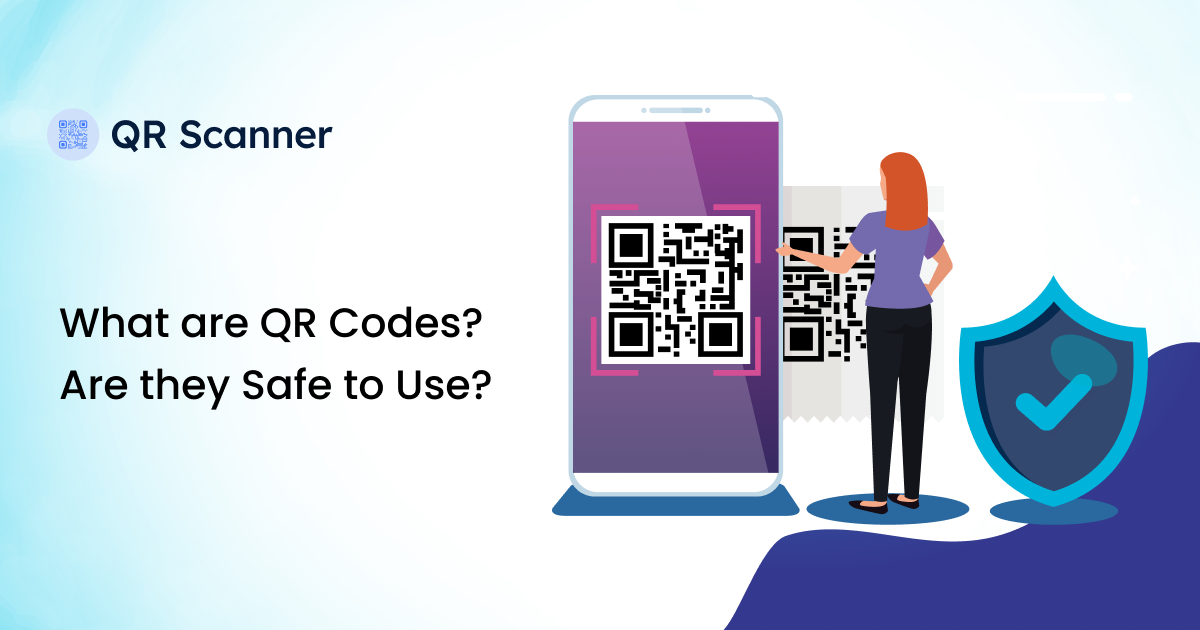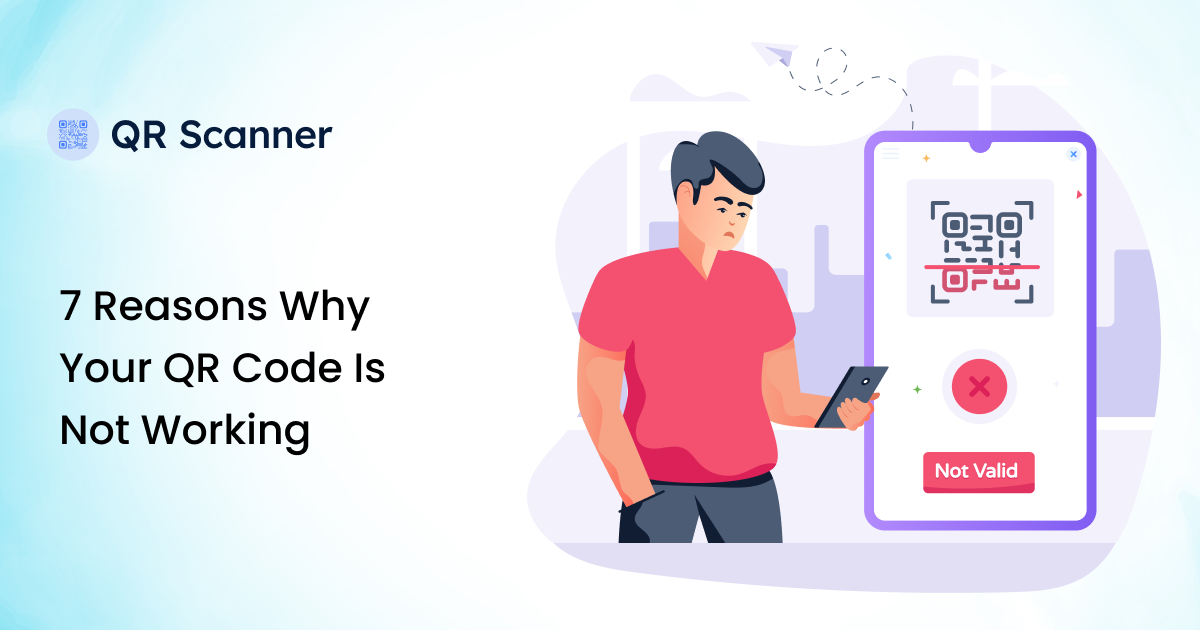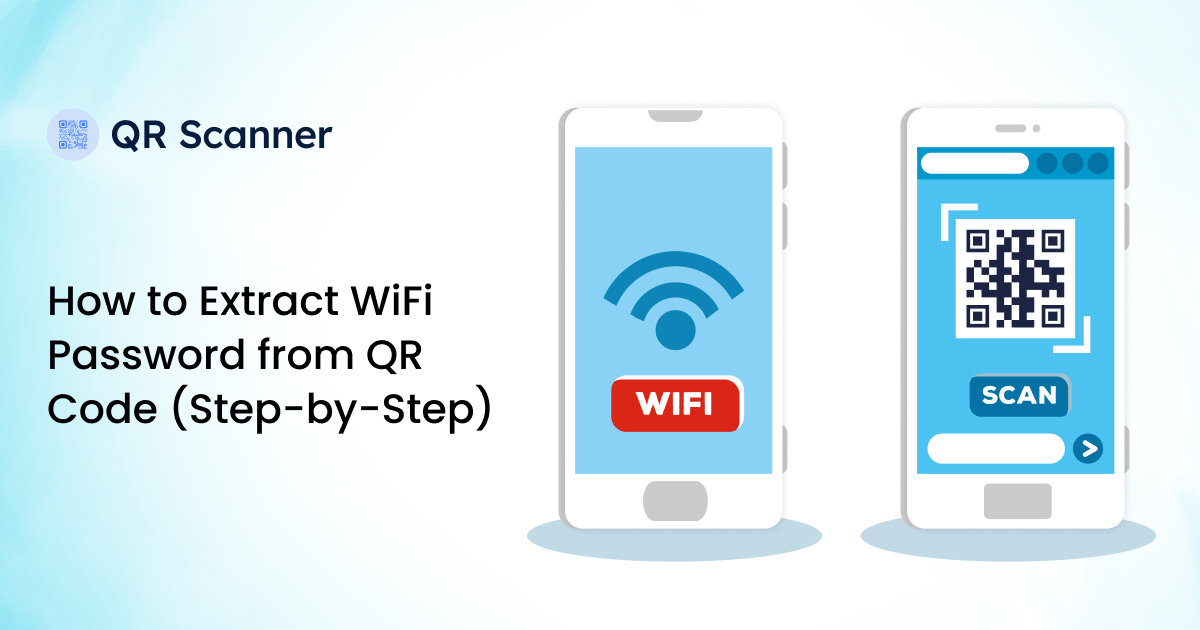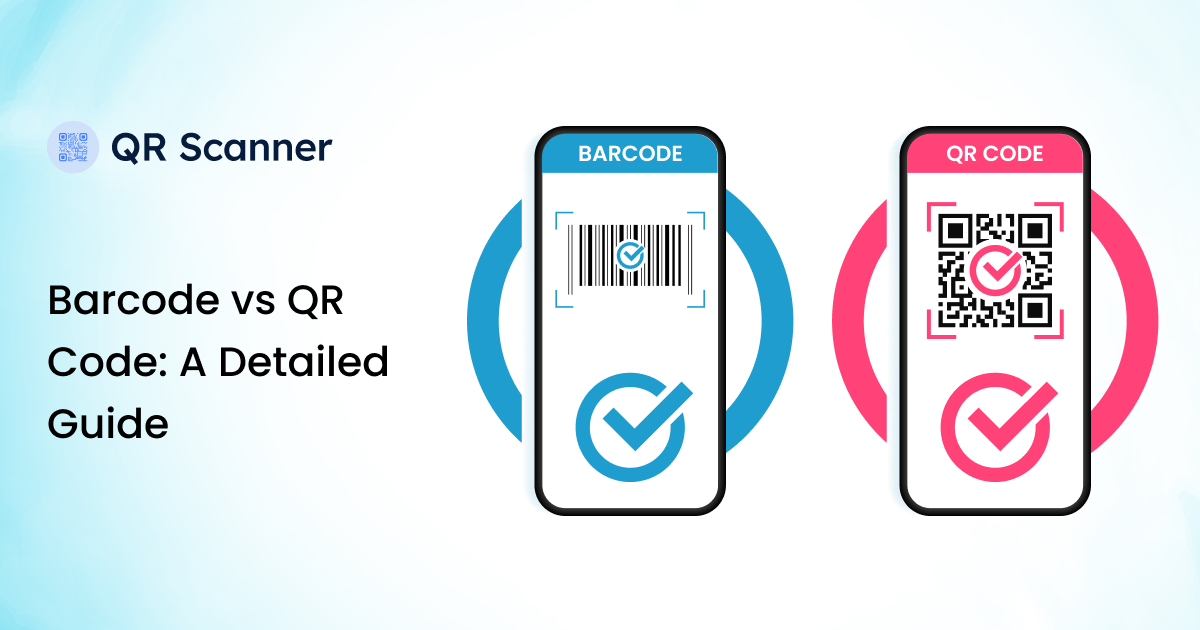What are QR Codes? Are they Safe to Use?

In this era of extreme digitalization, QR codes have become an integral part of our daily lives. It offers us a range of facilities, from online payments to authenticating online accounts; these black patterns are a great way of getting insights about the brand’s services, product lists, and other details connecting the physical and digital worlds.
However, as the concept of using QR codes is becoming more commonplace, the associated security concerns are also brought under the spotlight. Therefore, in order to gain an understanding of the QR codes and their security aspects, let’s discuss their basics and how safe they are to use.
What is a QR Code?
QR codes stand for “Quick Response codes.” These codes can store large amounts of data and information. Being a square-shaped grid with pixels, they allow users to access the information quickly when scanned through digital devices like smartphones, tablets, and others.
QR code systems work by encoding the data, including alphabets, numerics, symbols, links, sources, and other forms of information, into the two-dimensional code. This code is usually created using a QR code generator. This QR code can be easily scanned and decoded by the scanner through smartphones and other devices, accessing the users to the given data and sources.
Many devices have built-in camera scanning settings for QR scans. The camera takes a picture of the QR code, scans it through QR scanning software, and then links the user to the given data.
The first QR code system was developed by a Japanese automobile manufacturing company named Denso Wave, a subsidiary of Toyota, in 1994. The primary goal of this innovation was to have reliable, accurate, and error-free tracking of the vehicles’ parts in the supply chain.
After the success of QR codes within the company, Denso Wave made the QR technology accessible to the public. This means that anyone can use QR technology without infringing upon the rights of Denso Wave.
Initially, QR technology was quite slow in growth globally, but with time, QR codes become more popular and beneficial than traditional barcodes. Unlike bar codes, QR codes have a larger capacity for storing alphanumeric data, symbols, links, and other information as they read in two directions.
The primary objective of using QR codes is to quickly and easily access data and information. For example:
- Enabling the customers to access the company's social media pages or website through QR codes printed on products and pamphlets.
- Verifying logging in and signing up activity in sensitive accounts like digital banks and wallets.
- Makes online payment transactions reliable and quick by scanning QR codes.
- Helps download authentic applications from Apple or Google Store using QR codes, saving time and effort.
How Do QR Codes Work?
QR codes are an advanced version of barcodes encoded with various data types, including alphabets, numbers, alphanumeric characters, symbols, links, and other forms of information.
The data in these codes is encoded in a two-dimensional pattern of squares, and when the scanners examine these patterns, they convert the given data back to its original, decoded state.
To understand the concept of working with QR codes more thoroughly, learning about its primary parts is critical. So, let’s have a quick look at the parts of QR code technology:
1. Data Module
The data modules are the small black squares on the white background that make the integral and majority of the part of QR codes. The color combination of the QR codes can be different, but black-and-white is considered the standard. The arrangement of these data modules carries all the data and information in binary form and provides information on scanning.
2. Position Markers
Three position markers, also known as alignment patterns, are present at the corners of QR codes and are meant to help the scanner locate the right arrangement of the data modules. These position markers are distinctly designed from the rest of the code. They contain either two concentric circles or squares.
3. Quiet Zone
Quiet zones are the surrounding empty spaces in QR codes. They appear as white spaces. The quiet zones help the scanner in knowing the start and end of the code.
A QR can contain a maximum of 177 rows and 177 columns, making up 31,329 data modules. However, most of the data modules are not that comprehensive and have way fewer rows and columns.
To scan a QR code, you need a QR scanner, also known as a QR code reader. It’s a software or application that is available on digital devices to scan the QR codes. The QR scanners work by taking a picture of the code through the camera and then scanning it, enabling the users to access the data and information encoded in the code quickly.
Today, QR code scanners are readily available on smartphones. Additionally, there are many online software and applications for QR scanning available for download on Apple Store or Play Store. You can scan the QR code from your device by following the steps mentioned below:
- Open the camera or QR scanner app on your smartphone.
- Position your camera in the direction of the QR code in such a way that the whole QR code can fit on your phone screen.
- Your phone will quickly scan the code and show the decoded information on the screen.
- Proceed further according to the information on your phone.
The Versatility of QR Codes
QR codes are known for their ease of use and comfort, especially from the consumer's perspective. They have become an integral part of our highly digitalized and modernized lives, storing data and information securely and making it easy to access them.
Following are some of the aspects of QR codes that affect our daily lives positively:
- QR codes enable users to have contactless payments through digital wallets and apps like Google Pay and Apple Pay.
- It eliminated the chances of manual error in password typing by providing scanning Wi-Fi connections.
- Customers can easily track the progress of their shipments in the supply chain by scanning the QR code of the order.
- With the help of QR codes, medical professionals can easily track their past lifetime records by scanning a particular patient’s code in hospitals.
- The restaurants and shops can boost convenience and efficiency by providing their menus, service lists, and product descriptions to buyers through QR codes.
- Marketers use QR codes to enable their customers to learn about their brand, services, products, location, contact details, prices, reviews, and other information.
- The QR codes are a great way of authenticating products and services, ensuring high-quality and effective outcomes.
QR Code Security Concerns
QR codes are widely used worldwide due to their convenience and effectiveness. Along with its extensive use, many security and protective concerns are raised regarding its wide usage. Therefore, users should exercise caution when scanning QR codes from unknown or untrusted sources, which may lead to potentially harmful websites or applications.
In some cases, malicious QR codes could be used to distribute malware or deceive users into visiting fraudulent websites, potentially compromising their smartphone's security. Thus, to minimize the risks associated with QR codes, it’s advised only to scan QR codes from trusted sources and avoid malicious malware.
In addition to violating privacy rights, the fraudulent QR codes may misguide the customers, making them trust fraudulent websites and purchase fake products. Similarly, QR codes for digital wallets are a potential risk of stealing money from bank accounts or causing trouble in digital banking systems.
QR Code Security Measures
Where QR codes bring ease in life, the potential security threats can significantly affect the lives of users and business owners. Therefore, the following are the most recommended measures to ensure better security and protect the data.
1. Use Authentic Sources
Always scan QR codes from authentic sources like brands, registered companies, and validated individuals only. Avoid scanning risky QR codes from your personal devices.
2. Update Your Scanners Versio
Ensure that your QR scanner apps are up to date. Also, ensure that any hardware-level scanners have both their firmware and software updated to keep up with security.
3. Review and Manage The Scanning Permissions
Regularly review and manage the permissions of your QR scanning app on your phone to make sure that your device is not automatically scanning codes, which might be potentially risky.
4. Secure Internet Connection
Make sure that your device is connected to a secure and protective internet connection while scanning a QR code to avoid potential chances of threats and stealing of your data. This means don’t scan QR codes on public wifi.
5. Spread Awareness
Educate yourself about the common QR code patterns as well as suspecting suspicious and malicious QR codes, especially in public places.
6. Implement Multi-Factor Authentication
Add multi-factor authentication, especially in payment aspects, to avoid potential risks in your digital banking system.
7. Avoid Sharing Personal and Sensitive Information
Avoid sharing personal information on sourced websites and other digital platforms to decrease the threat of sensitive information theft.
8. Avoid Damaged QR Codes
If the QR code is damaged or torn, avoid scanning it, as it might be an indication of malicious activity or malware in the source.
So, above are some of the safety tips for safe QR code usage. However, the chances of potential malware and malicious activity are always present. However, with effective management and protective measures, you can decrease the risk and make your practice safe to a greater extent.
Are QR Codes Safe to Use?
The concept of scanning QR codes is associated with both positive and negative aspects. Apart from the fact that it has made customers' lives simple and effective, the chances of QR code hacks in phones and stealing personal and sensitive data from devices are never zero.
However, by exercising safety measures and practices, users can decrease the chances of possible threats of using QR codes to a greater extent. From trusting the QR codes from authentic and authorized sources only to staying updated with the latest security advancements in applications, the QR codes can be considered safe to use if managed right.
Real-World Examples of QR Codes Security
Various real-world examples of QR codes serve as a source of understanding the potential risks and threats associated with this technology and the importance of protective measures. Here are some of the detailed examples:
(i) Successful QR Codes Applications
(a) Valuable Educational Resources
QR codes in books are a great source for accessing valuable educational resources. By scanning these QR codes, students cannot only reach authentic sources for knowledge and educational purposes but also avail of the greatest discounts on books, videos, lectures, quizzes, and other learning materials.
Moreover, many E-learning institutes offer special discounts and promotional prices for learning and interactive materials to students with their campus-based QR codes, making the learning experience accessible, quick, and effective for students.
(b) Digital Wallets and Cashless Payments
QR codes have become a preferred method for making cashless payments through digital wallets. Banks, service providers, franchises, and users develop unique QR codes to carry out secure online transactions through their phones. As QR codes are simple and quick, customers avoid standing at checkouts or carrying cash all the time.
Moreover, the QR codes are an authentic source of payments if the right security measures are taken, specifically those to prevent phishing. Whether it is retail payments or online shopping, QR codes make the buying process smooth and seamless.
(c) Museums and Art Exhibitions
QR codes have extensively transformed the arts and culture industry by enabling users to have a smooth and seamless experience. By scanning the QR codes, the visitors can learn more about the artists’ artwork, painting references, painter’s personal life, description, history, significance, insights, and other details.
Moreover, by scanning the codes, the physical or virtual visitors can access the webpages of the artist as well as explore their portfolio, learn about upcoming exhibitions, access exclusive content, and engage with the creative process on a more intimate level.
The QR codes also enable enthusiasts to attend online museum tours and virtual exhibitions by scanning the QR codes of the artists or galleries. They are also beneficial for selling paintings and artwork online rather than conducting physical open houses and exhibitions.
(ii) Failed QR Code Applications
(a) Risk of Data Theft
The potential risk of personal and sensitive data theft is constantly associated with the QR technology. The cybercriminals may develop a website similar to a well-known brand. Then, they generate the QR codes for their fake website and advertise them in places similar to the real brand by using similar designs.
This is known as phishing. Phishing attacks aim to bamboozle people by creating fake but convincing replications of authentic websites, emails, support messages, and more to dupe people.
When potential customers use the QR code and put their information on the website to log in or sign up, the hacker will steal all the user's information and use it for harmful purposes.
(b) Downloading Malicious Applications
Malicious applications are another risk highly associated with fake QR codes. Phishing has another role to play here. Only this time, instead of stealing data by fooling the user into giving away their login info, the goal is to get them to download malware.
When a customer scans the fake code through their phone and opens the links provided, dangerous malicious applications, software, and viruses download into their phone and cause all kinds of havoc.
These malware applications provide cyber criminals with unauthorized access to phones, accessing all personal and sensitive information and helping them carry out further cyberattacks.
(c) Cryptocurrency Theft
Cryptocurrency transactions are mostly carried out using QR codes, which are quick, reliable, and easy to use. However, cybercriminals replace the authentic QR code with their own generated one, resulting in risk to digital assets.
Because of these fraudulent QR codes, whenever a user tries to transfer money into their account by scanning the QR code, the user’s money or crypto assets are deposited in the criminal's account or digital wallet instead.
Moreover, it also helps them hack accounts and transfer all the money and currencies easily. Tracking the hacker is quite difficult and complex due to the blockchain nature of the crypto industry.
QR Code Security in the Future
The future of QR codes is associated with every retailing industry. Whether it is digital marketing and retailing or restaurants, the QR codes, in the form of cashless payments, have taken over the world by storm.
However, the security aspect of QR codes is still an underdeveloped concept. One noteworthy approach to making the QR code system more reliable and protective is integrating blockchains.
Moreover, advanced encryption techniques are also considered an excellent approach for protective measures.
In short, to fully understand the future trends of QR codes, particularly regarding security and protection, you have to stay updated with the latest advancements and stay informed and well aware of the potential risks and protective measures critical for optimum results.
Conclusion
While wrapping up our discussion, the QR codes, being a revolutionary step towards contactless payments, have a great and promising future due to the convenience and effectiveness they provide mankind. A simple process of scanning QR codes for more information to get deeper insights about the products: QR codes are truly a game changer in various industries. However, staying alert to malicious activities and malware is critical to being safe from damage as well as avoiding thefts of personal and sensitive information.
Related Blogs

7 Reasons Why Your QR Code Is Not Working
Learn our comprehensive guide on seven reasons why your QR Code is not working

How to Extract WiFi Password from QR Code (Step-by-Step)
Learn how to extract WiFi passwords from QR codes in just a few steps.
